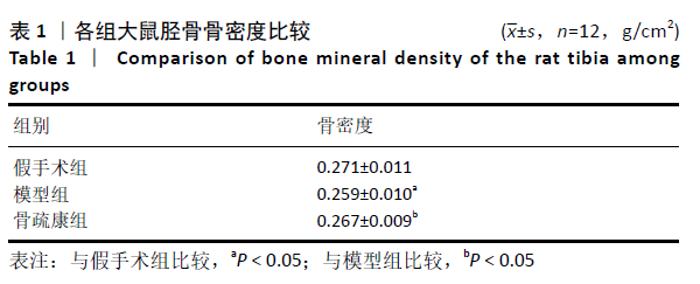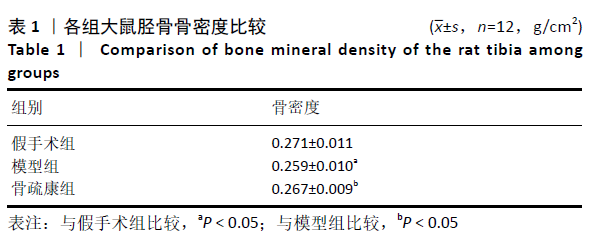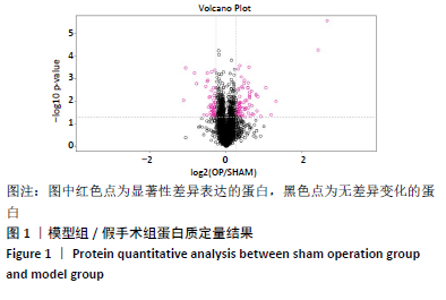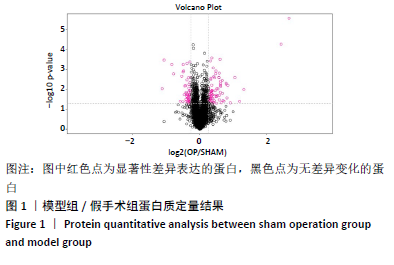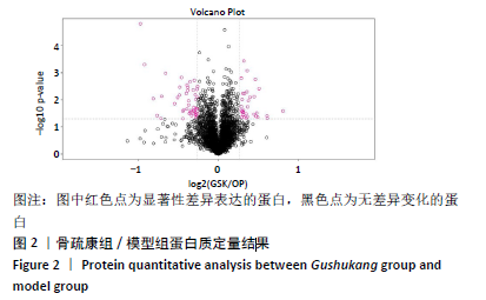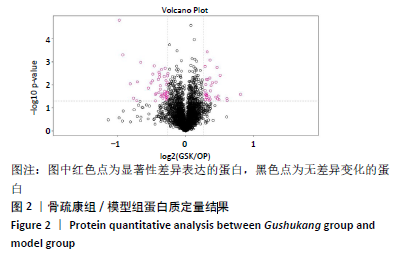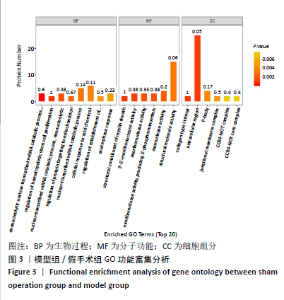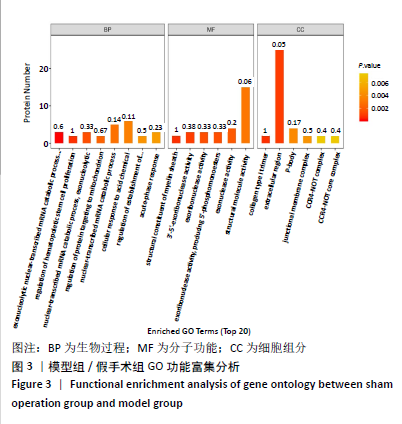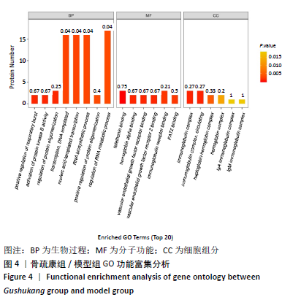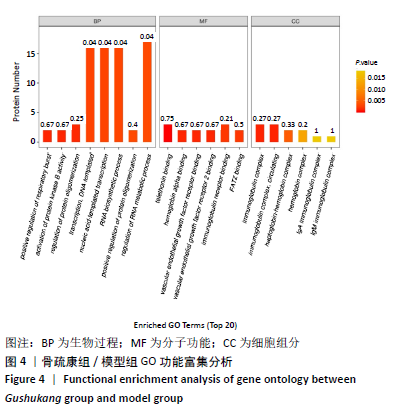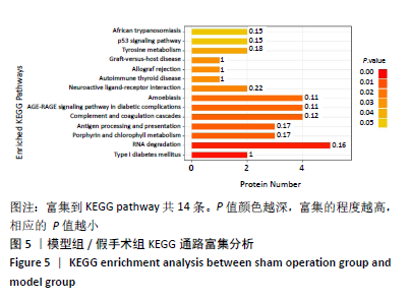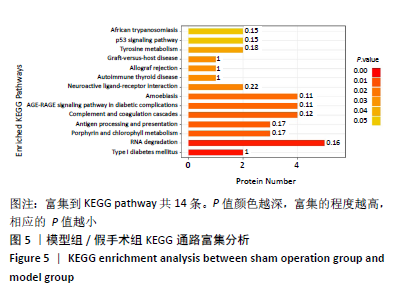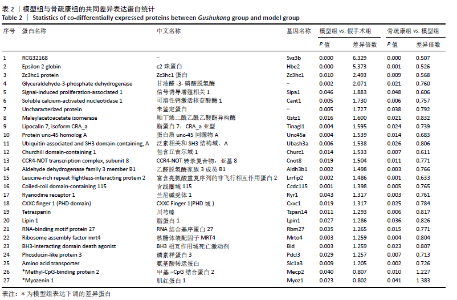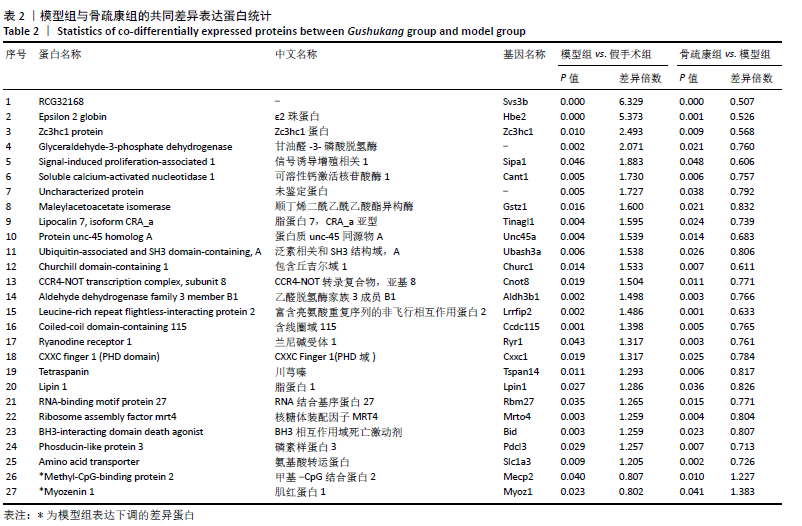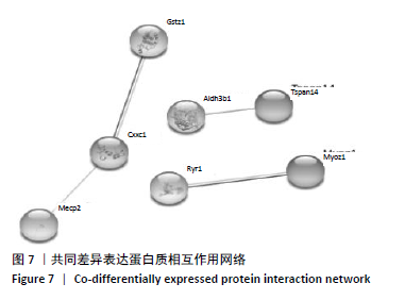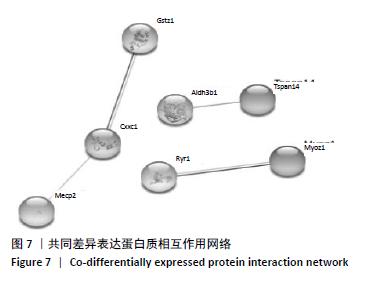Chinese Journal of Tissue Engineering Research ›› 2021, Vol. 25 ›› Issue (32): 5141-5147.doi: 10.12307/2021.216
Previous Articles Next Articles
Protective mechanism of Gushukang granule in a rat osteoporosis model based on TMT proteomic analysis
Lin Ruohui1, Chen Sainan2, Ye Yunjin2, Chen Juan2, Xie Lihua2, Huang Jingwen2, Ge Jirong2, Li Shengqiang2
- 1Fujian University of Traditional Chinese Medicine, Fuzhou 350122, Fujian Province, China; 2Osteoporosis Syndrome Genomics Laboratory, Fujian Academy of Traditional Chinese Medicine, Fuzhou 350003, Fujian Province, China
-
Received:2020-11-18Revised:2020-11-21Accepted:2021-01-09Online:2021-11-18Published:2021-07-26 -
Contact:Li Shengqiang, Associate researcher, Master’s supervisor, Osteoporosis Syndrome Genomics Laboratory, Fujian Academy of Traditional Chinese Medicine, Fuzhou 350003, Fujian Province, China -
About author:Lin Ruohui, Master candidate, Fujian University of Traditional Chinese Medicine, Fuzhou 350122, Fujian Province, China -
Supported by:Basic Scientific Research Project of Fujian Provincial Department of Science and Technology, No. 2019R1003-1 (to LSQ)
CLC Number:
Cite this article
Lin Ruohui, Chen Sainan, Ye Yunjin, Chen Juan, Xie Lihua, Huang Jingwen, Ge Jirong, Li Shengqiang. Protective mechanism of Gushukang granule in a rat osteoporosis model based on TMT proteomic analysis[J]. Chinese Journal of Tissue Engineering Research, 2021, 25(32): 5141-5147.
share this article
Add to citation manager EndNote|Reference Manager|ProCite|BibTeX|RefWorks
| [1] 夏维波,章振林,林华,等.原发性骨质疏松症诊疗指南(2017)[J].中国骨质疏松杂志,2019,25(3):281-309. [2] 金瑜.中医药治疗骨质疏松症的疗效分析[J].临床医药文献电子杂志,2019,6(20):72-73. [3] 王桂云,刘湘琳,陈沙,等.中医药治疗骨质疏松症的研究进展[J].湖南中医杂志,2020,36(6):162-165. [4] 吴迪,林逸轩,李金菊,等.中医药治疗骨质疏松症近10年临床研究进展[J].中医药临床杂志,2019,31(11):2038-2041. [5] 周一林,许长鹏,戚芮榛,等.基于iTRAQ技术的BMP-2诱导肌源C2C12细胞向成骨细胞分化过程中的蛋白质组学研究[J].中华骨科杂志,2015,35(6):663-669. [6] 邢燕,毕宏焱,张倩楠,等.骨质疏松常用中成药介绍[J].中国骨质疏松杂志,2013,19(1):83-85,96. [7] 陈勇.骨疏康胶囊治疗绝经后骨质疏松性转子间骨折的临床效果分析[J].中国骨质疏松杂志,2019,25(11):1571-1575. [8] 成洁,王颖,吉健华,等.骨疏康胶囊治疗肾阳虚型骨质疏松症疗效及对患者骨代谢影响[J].陕西中医,2019,40(9):1232-1234. [9] 郑志坚,舒冰,赵世天,等.骨疏康颗粒对去卵巢小鼠骨质疏松模型骨丢失和破骨细胞凋亡的影响[J].中华中医药杂志,2020,35(7): 3647-3651. [10] LEI C, WANG Q, TANG N, et al. GSTZ1‐1 downregulates Wnt/β‐catenin signalling in hepatocellular carcinoma cells. FEBS Open Bio. 2020; 10(1):6-17. [11] ARCIERO E, BIAGINI SA, CHEN Y, et al. Genes Regulated by Vitamin D in Bone Cells Are Positively Selected in East Asians. PloS one. 2015; 10(12):e146072. [12] KOCH M, MOLLENKOPF HJ, KLEMM U, et al. Induction of microRNA-155 is TLR- and type IV secretion system-dependent in macrophages and inhibits DNA-damage induced apoptosis. Proc Natl Acad Sci U S A. 2012;109(19):E1153-E1162. [13] FAIENZA MF, VENTURA A, MARZANO F, et al. Postmenopausal osteoporosis: the role of immune system cells. Clin Dev Immunol. 2013;2013:575936. [14] 王和鸣,葛继荣,石关桐,等.骨疏康胶囊治疗骨质疏松症临床试验总结[J].中国中医骨伤科杂志,2006,14(6):10-15. [15] 黄莉,李悦,邱建利,等.骨疏康治疗原发性骨质疏松症随机对照临床研究Meta分析[J].辽宁中医药大学学报,2016,18(4):85-88. [16] 王锡娟,梁日欣,赵璐,等.中药复方骨疏康防治骨质疏松症研究进展[J].中国中西医结合杂志,2007,27(3):282-285. [17] WANG Q, ZHAO Y, SHA N, et al.The systemic bone protective effects of Gushukang granules in ovariectomized mice by inhibiting osteoclastogenesis and stimulating osteoblastogenesis. J Pharmacol Sci. 2018;136(3):155-164. [18] CHAI S, WAN L, WANG JL, et al. Gushukang inhibits osteocyte apoptosis and enhances BMP-2/Smads signaling pathway in ovariectomized rats.Phytomedicine. 2019;64:153063. [19] LI XL, WANG L, BI XL, et al. Gushukang exerts osteopreserve effects by regulating vitamin D and calcium metabolism in ovariectomized mice. J Bone Miner Metab. 2019;37(2):224-234. [20] YUAN Y, YANG L, LIU T, et al. Osteoclastogenesis inhibition by mutated IGSF23 results in human osteopetrosis. Cell Prolif. 2019;52(6):e12693. [21] 谢兴文,李建国,黄晋,等.血管内皮生长因子防治骨质疏松的研究进展[J].中国骨质疏松杂志,2019,25(7):1030-1033. [22] 钱洲曜, 王勇平.血管内皮生长因子有望成为加速骨折愈合的全新治疗手段[J].中国组织工程研究,2020,24(17):2759-2769. [23] 戴晨琳,丁晓颖,张鑫,等.四环素-精氨酸-甘氨酸-天门冬氨酸-酪氨酸的体内分布及其对骨代谢的作用[J].中国医学科学院学报,2004,26(4):399-404. [24] JAFARIPOUR S, SASANEJAD P, DADGARMOGHADDAM M, et al. ADAMTS7 and ZC3HC1 Share Genetic Predisposition to Coronary Artery Disease and Large Artery Ischemic Stroke. Crit Rev Eukaryot Gene Expr. 2019;29(4):351-361. [25] MA H, HE Y, BAI M, et al. The genetic polymorphisms of ZC3HC1 and SMARCA4 are associated with hypertension risk. Mol Genet Genomic Med. 2019;7(11):e942. [26] MA TT, LI XF, LI WX, et al. Geniposide alleviates inflammation by suppressing MeCP2 in mice with carbon tetrachloride-induced acute liver injury and LPS-treated THP-1 cells. Int Immunopharmacol. 2015;29(2):739-747. [27] SHAPIRO JR, BOSKEY AL, DOTY SB, et al. Zoledronic acid improves bone histomorphometry in a murine model of Rett syndrome. Bone. 2017;99:1-7. [28] BLUE ME, BOSKEY AL, DOTY SB, et al. Osteoblast function and bone histomorphometry in a murine model of Rett syndrome. Bone. 2015; 76:23-30. [29] XIAO P, CHEN Y, JIANG H, et al. In vivo genome-wide expression study on human circulating B cells suggests a novel ESR1 and MAPK3 network for postmenopausal osteoporosis. J Bone Miner Res. 2008;23(5): 644-654. [30] KITAZAWA R, KITAZAWA S.Methylation status of a single CpG locus 3 bases upstream of TATA-box of receptor activator of nuclear factor-kappaB ligand (RANKL) gene promoter modulates cell- and tissue-specific RANKL expression and osteoclastogenesis. Mol Endocrinol. 2007;21(1):148-158. [31] 彭涛,李爱国,何培亮.绝经后骨质疏松与氧化应激相关研究进展[J].中外医学研究,2020,18(10):186-188. [32] 孙振双,耿元卿,张丽君,等.氧化应激介导绝经后骨质疏松发病机制的研究进展[J].中国骨质疏松杂志,2016,22(8):1063-1067. [33] WITHERSPOON JW, MEILLEUR KG.Review of RyR1 pathway and associated pathomechanisms. Acta Neuropathol Commun. 2016;4(1): 121. [34] ZAIDI M, MOONGA BS, HUANG CL. Calcium sensing and cell signaling processes in the local regulation of osteoclastic bone resorption. Biol Rev Camb Philos Soc. 2004;79(1):79-100. [35] 刘慧. MicroRNA-432影响成肌细胞增殖及其通过靶向MYOZ1基因影响肌纤维类型标记基因的表达[D].武汉:华中农业大学,2013. [36] ITO K, OOKAWARA S, HIBINO Y, et al. Skeletal Muscle Mass Index Is Positively Associated With Bone Mineral Density in Hemodialysis Patients. Front Med (Lausanne). 2020;7:187. [37] 李扬,温有锋,李文慧.骨质疏松对骨骼肌含量及少肌症的影响[J].解剖学杂志,2018,41(1):67-70. [38] TORRICELLI P, FINI M, GIAVARESI G, et al. Human osteopenic bone-derived osteoblasts: essential amino acids treatment effects. Artif Cells Blood Substit Immobil Biotechnol. 2003;31(1):35-46. [39] ZHANG AH, MA ZM, SUN H, et al. High-Throughput Metabolomics Evaluate the Efficacy of Total Lignans From Acanthophanax Senticosus Stem Against Ovariectomized Osteoporosis Rat. Front Pharmacol. 2019;10:553. [40] 徐君翔,徐又佳,林华.“铁调素-Jak/Stat通路-骨代谢”相关性研究近况[J].中国骨质疏松杂志,2013,19(7):740-743. [41] 马铭,任汉强.IL-37通过调控M-CSF和抑制IL-6-JAK2/STAT3信号通路抑制骨质疏松的机制研究[J].中国免疫学杂志,2017,33(10): 1552-1556. [42] 陈立业,蔡迎峰,刘保新,等.补肾活血方对绝经后骨质疏松症患者JAK/STAT信号通路的影响[J].现代医院,2020,20(6):895-897. [43] 陈娟,谢丽华,李生强,等.JAK/STAT通路介导的六味地黄丸对绝经后骨质疏松症肾阴虚证的免疫调节作用[J].中华中医药杂志, 2017,32(4):1747-1750. [44] KIMBLE RB. Alcohol, Cytokines, and Estrogen in the Control of Bone Remodeling. Alcohol Clin Exp Res. 1997;21(3):385-391. [45] Iwaniec UT, TURNER RT. Intraperitoneal injection of ethanol results in drastic changes in bone metabolism not observed when ethanol is administered by oral gavage. Alcohol Clin Exp Res. 2013;37(8): 1271-1277. [46] 申意伟,徐西林,张晓峰,等.酒精对骨组织代谢影响机制的研究进展[J].中国骨质疏松杂志,2020,26(2):298-301. |
| [1] | Guo Shuhui, Yang Ye, Jiang Yangyang, Xu Jianwen. Screening and validation of neurogenic bladder miRNA-mRNA regulatory network [J]. Chinese Journal of Tissue Engineering Research, 2023, 27(在线): 1-8. |
| [2] | Dang Yi, Du Chengyan, Yao Honglin, Yuan Nenghua, Cao Jin, Xiong Shan, Zhang Dingmei, Wang Xin. Hormonal osteonecrosis and oxidative stress [J]. Chinese Journal of Tissue Engineering Research, 2023, 27(9): 1469-1476. |
| [3] | Sun Jiajia, Zhu Haidi, Lu Yun, Zhang Kai. Comparison of bone metabolism markers between type 2 diabetes mellitus and non-type 2 diabetes mellitus patients with hip fracture [J]. Chinese Journal of Tissue Engineering Research, 2023, 27(8): 1156-1160. |
| [4] | Shao Zichen, Li Huanan, Gu Bing, Zhang Xiaoyun, Sun Weikang, Liu Yongqian, Gan Bin. MicroRNA, long non-coding RNA and circular RNA mediate the mechanism of decreasing uric acid, anti-inflammation and regulating bone metabolism in gout [J]. Chinese Journal of Tissue Engineering Research, 2023, 27(5): 765-771. |
| [5] | Yuan Changshen, Guan Yanbing, Li Zhe, Rong Weiming, Liao Shuning, Chen Lewei, Mei Qijie, Duan Kan. Screening and verification of key genes of necroptosis in osteoarthritis [J]. Chinese Journal of Tissue Engineering Research, 2023, 27(5): 695-700. |
| [6] | Li Zhe, Yuan Changshen, Guan Yanbing, Xu Wenfei, Liao Shuning, Rong Weiming, Mei Qijie, Duan Kan. Bioinformatic analysis and experimental validation of ferroptosis in osteoarthritis [J]. Chinese Journal of Tissue Engineering Research, 2023, 27(17): 2637-2643. |
| [7] | Wu Ruiqi, Cui Wei, Yang Qipei, Zhou Yi, Zhang Xuan. Therapeutic mechanism of traditional Chinese medicine in the treatment of hormone-induced necrosis of the femoral head [J]. Chinese Journal of Tissue Engineering Research, 2023, 27(17): 2763-2771. |
| [8] | Sun Hong, Deng Jin, Peng Guoxuan, Zhuang Yong, Liu Miao, Ning Xu, Yang Hua. Identification and function of differentially expressed long noncoding RNAs in the chondrogenesis of human adipose-derived mesenchymal stem cells [J]. Chinese Journal of Tissue Engineering Research, 2023, 27(15): 2325-2332. |
| [9] | Niu Jingwei, Zhang Qingtao, Wang Na, Guan Shuo, Wang Ying. Correlation analysis between thyroid function-related Thrβ and Thrsp genes and mechanical properties of Achilles tendon development in rats [J]. Chinese Journal of Tissue Engineering Research, 2023, 27(11): 1653-1658. |
| [10] | Wang Weiwei, Ou Zhixue, Zhou Yi, Li Tong. Bioinformatics analysis of cuproptosis genes in immune infiltration of osteoarthritis [J]. Chinese Journal of Tissue Engineering Research, 2023, 27(11): 1669-1676. |
| [11] | Zhang Haiyong, Huang Jingwen, Xie Bingying, Chen Sainan, Xie Lihua, Chen Xuan, Li Shengqiang, Ge Jirong. Anti-osteoporosis effect of Gushukang in ovariectomized rats: a lumbar metabonomic analysis [J]. Chinese Journal of Tissue Engineering Research, 2022, 26(32): 5185-5190. |
| [12] | Wen Xiaoyu, Sun Yuhao, Li Zhuoxian, Xu Lijing, Xia Meng. Network pharmacology and proteomics analysis of Jiawei Xiaoyao San in the treatment of liver cancer complicated with depression in rats [J]. Chinese Journal of Tissue Engineering Research, 2022, 26(32): 5132-5142. |
| [13] | Lu Pengcheng, Liu Bo, Jin Shengjie, Tian Zhikai, Zeng Xinyu, Chen Xianghe. Hypothalamus: the key controller for exercise-improved bone metabolism [J]. Chinese Journal of Tissue Engineering Research, 2022, 26(32): 5201-5208. |
| [14] | Song Na, Liu Guanjuan, Luo Shanshan, Huo Hua, Cheng Yuting, Hong Wei, Liao Jian. Autophagy and inflammation-induced alveolar bone metabolism [J]. Chinese Journal of Tissue Engineering Research, 2022, 26(32): 5217-5222. |
| [15] | Liao Rongzhen, Chen Dejun, He Mincong, Huang Xingru, Fang Jian, Zhu Genfu. Correlation between TCM syndrome types and ERK in lipid metabolism of senile osteoporosis [J]. Chinese Journal of Tissue Engineering Research, 2022, 26(29): 4704-4708. |
| Viewed | ||||||
|
Full text |
|
|||||
|
Abstract |
|
|||||
